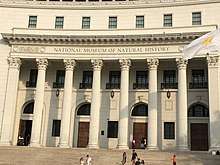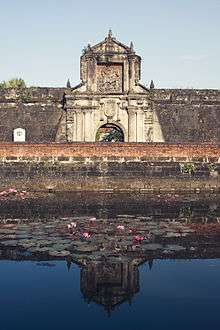Rizal Park
Rizal Park (Filipino: Liwasang Rizal, Spanish: Parque Rizal), also known as Luneta Park or simply Luneta, is a historic urban park located in Ermita, Manila, Philippines which is considered as one of the largest urban parks in Asia, covering an area of 58 hectares (140 acres). The site on where the park is situated was originally known as Bagumbayan during the Spanish Colonial Period. It is adjacent to the historic Walled City of Intramuros and is a major tourist destination in the Philippines.
| Rizal Park | |
|---|---|
| Luneta Park | |
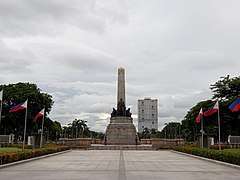 The Rizal Monument in Rizal Park | |
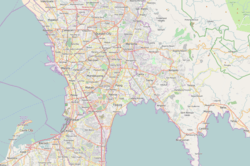 .svg.png) | |
| Type | Urban Park |
| Location | Roxas Boulevard, Ermita, Manila, Philippines |
| Coordinates | 14°34′57″N 120°58′42″E |
| Area | 58 hectares (140 acres) |
| Created | 1820 |
| Administered by | National Parks Development Committee |
| Plants | 3,497 trees (2015) |
| Species | 112 tree species (2015) |
| Public transit access | |
| Website | rizal |
Situated on the eastern shores of Manila Bay, the park plays a significant role in shaping the history of the Philippines. The execution of Filipino patriot José Rizal on December 30, 1896 fanned the flames of the 1896 Philippine Revolution against the Kingdom of Spain. The park was officially named in his honor, and the monument enshrining his remains serves as the park's symbolic focal point. The Declaration of Philippine Independence from the United States was held here on July 4, 1946 as were later political rallies including those of Ferdinand Marcos and Corazon Aquino in 1986 that culminated in the EDSA Revolution.
History
Spanish colonial period
Rizal Park's history began in 1820 when the Paseo de Luneta was completed just south of the walls of Manila on a marshy patch of land next to the beach during the Spanish rule. Prior to the park, the marshy land was the location of a small town called Nuevo Barrio (New Town or Bagumbayan in Tagalog language) that dates back to 1601. The town and its churches, being close to the walled city, were strategically used as cover by the British during their attack. The Spanish authorities anticipated the danger posed by the settlements that immediately surrounded Intramuros in terms of external attacks, yet Church officials advocated for these villages to remain. Because of the part they played during the British Invasion, they were cleared after the short rule of the British from 1762 to 1764.[1] The church of Bagumbayan originally enshrined the Black Nazarene. Because of the order to destroy the village and its church, the image was transferred first to San Nicolas de Tolentino then to Quiapo Church. This has since been commemorated by the Traslación of the relic every January 9, which is more commonly known as the Feast of the Black Nazarene. This is why the processions of January 9 have begun there in the park beginning in 2007.[2] After the clearing of the Bagumbayan settlement, the area later became known as Bagumbayan Field where the Cuartel la Luneta (Luneta Barracks), a Spanish Military Hospital (which was destroyed by one of the earthquakes of Manila), and a moat-surrounded outwork of the walled city of Manila, known as the Luneta (lunette) because of its crescent shape.[3][4]

West of Bagumbayan Field was the Paseo de la Luneta (Plaza of the Lunette) named after the fortification, not because of the shape of the plaza which was a long 100-by-300-metre (330 ft × 980 ft) rectangle ended by two semicircles. It was also named Paseo de Alfonso XII (Plaza of Alfonso XII), after Alfonso XII, King of Spain during his reign from 1874 to 1885.[5] Paseo de la Luneta was the center of social activity for the people of Manila in the early evening hours. This plaza was arranged with paths and lawns and surrounded by a wide driveway called "La Calzada" (The Road) where carriages circulate.[3][4]
Execution of Gómez, Burgos and Zamora
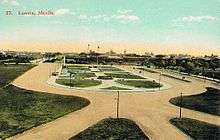
During the Spanish period from 1823 to 1897 most especially in the latter part, the place became notorious for public executions. A total of 158 political enemies of Spain were executed in the park.[4] On February 17, 1872, three Filipino priests, Mariano Gómez, José Burgos, and Jacinto Zamora, collectively known as Gomburza, were executed by garrote, accused of subversion arising from the 1872 Cavite mutiny.[6]
American colonial period
Rizal Monument
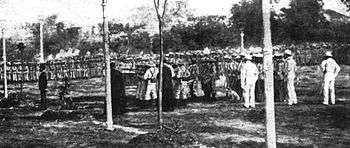
The bronze-and-granite Rizal monument is among the most famous sculptural landmarks in the country. It is almost protocol for visiting dignitaries to lay a wreath at the monument. Located on the monument is not merely the statue of Rizal, but also his remains.[7]
On September 28, 1901, the United States Philippine Commission approved Act No. 243, which would erect a monument in Luneta to commemorate the memory of José Rizal, Filipino patriot, writer and poet.[8] The committee formed by the act held an international design competition between 1905 and 1907 and invited sculptors from Europe and the United States to submit entries with an estimated cost of ₱100,000 using local materials.[9]
The first-prize winner was Carlos Nicoli of Carrara, Italy for his scaled plaster model titled "Al Martir de Bagumbayan" (To the Martyr of Bagumbayan) besting 40 other accepted entries. The contract though, was awarded to second-placer Swiss sculptor named Richard Kissling for his "Motto Stella" (Guiding Star).
After more than twelve years of its approval, the shrine was finally unveiled on December 30, 1913 during Rizal's 17th death anniversary. His poem "Mi Ultimo Adios" ("My Last Farewell") is inscribed on the memorial plaque. The site is continuously guarded by ceremonial soldiers of Philippine Marine Corps’ Marine Security and Escort Group[10]
National Government Center
In 1902,[11] William Taft commissioned Daniel Burnham, architect and city planner, to do the city plan of Manila. Government buildings will have Neo-classical edifices with Greco-Roman columns. Burnham chose Luneta as the location of the new government center. A large Capitol building, which was envisioned to be the Philippine version of the Washington Capitol, was to become its core. It was to be surrounded by other government buildings, but only two of those buildings were built around Agrifina Circle, facing each other. They are the Department of Agriculture (now the National Museum of Anthropology) and the Department of Finance (It became the department of Tourism and is now the National Museum of Natural History). These two buildings were completed before the Second World War.[12]
The park was also intended to become a Philippine version of The Mall in Washington, D.C., with the planned building of the government offices.
Luneta National Park
In August 1954, President Ramon Magsaysay created the Jose Rizal National Centennial Commission to organize and manage the celebrations for the centennial of José Rizal's birth.[13] Its plans include building a grand monument of José Rizal and the Rizal Memorial Cultural Center that would contain a national theater, a national museum, and a national library at the Luneta.[14] The site was declared a national park on December 19, 1955 by virtue of Proclamation No. 234 signed by President Magsaysay.[15] The Luneta National Park spans an area of approximately 16.24 hectares (40.1 acres) covering the area surrounding the Rizal Monument. The Commission of Parks and Wildlife (now Biodiversity Management Bureau) managed the site upon its establishment as a protected area.
In 1957, President Carlos P. Garcia issued Proclamation No. 470 transferring the administration of the national park to the Jose Rizal National Centennial Commission.[16] In 1961, in commemoration of Rizal's birth centennial, the National Library was inaugurated at the park.[14] Its management was then handed over to the National Parks Development Committee, an attached agency of the Department of Tourism, created in 1963 by President Diosdado Macapagal.[17][18] In 1967, the Luneta National Park was renamed to Rizal Park with the signing of Proclamation No. 299 by President Ferdinand Marcos.[19]
Philippine Centennial
On June 12, 1998, the park hosted many festivities which capped the 1998 Philippine Centennial, the event commemorating a hundred years since the Declaration of Independence from Spain and the establishment of the First Philippine Republic. The celebrations were led by then President Fidel V. Ramos.[20]
2011 renovations
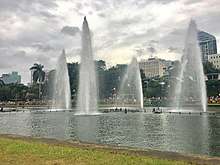
Rizal Park was renovated by the National Parks Development Committee in 2011. The German-Filipino William Schaare, who built the old musical dancing fountain at the 40 m × 100 m (130 ft × 330 ft) pool in the 1960s, handled its restoration. Among the other things that were restored were the Flower Clock (now known as the World-Class Filipino Bloom), the Noli Me Tangere Garden and the Luzviminda Boardwalk, which were opened just in time for the 150th birthday celebration of Jose Rizal.[21]
Contemporary history
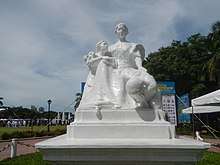
In November 2019, La Madre Filipina was transferred back to its original site in Jones Bridge after 73 years of staying at the Park. Its plinth were reconstructed using the original neoclassic design during the 2019 redevelopment of the bridge.
Due to the COVID-19 pandemic, Rizal Park was temporarily closed to the public.[22] Rizal Park partially reopened on July 1, 2020, for jogging and exercise activities only.
Proposal for the transfer of the park's administration to the City of Manila
In 2019, House Bill No. 2594 was introduced by Buhay Party-List Congressman Lito Atienza, a former Mayor of Manila, seeking the return of ownership and management of the park from the NPDC to the City Government of Manila.[23] The transfer of administration, management, maintenance and operation of the Park including all of its activities, facilities and improvements thereafter, in pursue of Republic Act No. 7160, also known as the Local Government Code of 1991, which encouraged the transfer of power and authority from the National Government to Local Government Units (LGU), in line with the government's devolution program as mandated by the Constitution. The park is also dependent of the services the city renders. National parks which were now administered by LGUs include the Hundred Islands National Park (ownership transferred to Alaminos, Pangasinan in 2005) and the Quezon Memorial Circle (ownership transferred to Quezon City in 2008).
Notable events
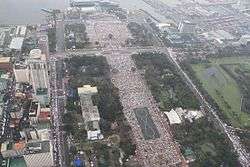
- Various mass protests were held during 1986 as opposition to the government of Ferdinand Marcos. This culminated into the People Power Revolution.
- January 15, 1995. The closing Mass of the 10th World Youth Day 1995 was held here attended by more than 10 million people. This is the record gathering of the Roman Catholic Church.
- June 12, 1998. The Philippine Centennial Celebrations featured a Grand Centennial Parade culminating in a fireworks display emanating from ships in Manila Bay that was the most expensive ever produced in the country at the time. Rizal Park had over five million celebrating the one hundredth anniversary of the Philippine Declaration of Independence.
- December 31, 1999 – January 1, 2000. The turn-of-the-century celebration was held here attended by more than 500,000 people.
- November 27, 2005. Rizal Park was the venue of the opening ceremony for the 2005 Southeast Asian Games at the Quirino Grandstand. It was held at an open-air park instead of a stadium, a historic first for a Southeast Asian games' opening ceremony. It was again used on December 5, 2005 for the games' closing ceremony.
- August 23, 2010. The park was the site of the 11-hour hostage crisis where a Hong Thai Travel Services tour group on a coach was hijacked by Rolando Mendoza, causing casualties and injuries.
- August 22–26, 2013. The Million People March was held in the park, and other different locations, to protest against the improper use of Priority Development Assistance Fund.
- January 18, 2015. The concluding mass of the Papal visit of Pope Francis was held here attended by more than 6 million people, making it the largest papal gathering in history.[24]
Recurring events
- Monthly Flag-Raising Ceremony held every first Monday of the month at the Independence Flagpole for public – started October 2019.
- The annual Independence Day (June 12), Rizal Day (December 30) and New Year's Eve (December 31) celebrations are held at the park.
- The park is the traditional end of the Marlboro Tour (now known as the Tour de Filipinas), the national road bicycle racing event every April or May. Recently, the tour has ended in Baguio.
- The park is also the host of the National Milo Marathon.
- The parade of floats for the Metro Manila Film Festival is annually held every Christmas. Recently, the cities and towns in Metro Manila have begun rotating the hosting of the parade.
- Presidential inaugurations are usually held in the park every June 30, six years starting from 1992.
Park layout
The park is divided into three sections:
Northeastern Section: This 16-hectare (40-acre) section is designated as the National Museum Complex which includes the Agrifina Circle, and where the National Museum of Natural History and the National Museum of Anthropology are located.
Central Section: Located south of Maria Orosa Street is the 22-hectare (54-acre) park proper that extends down up to Roxas Boulevard. This is where the Rizal Monument and several attractions such as the Open-Air Auditorium, Independence Flagpole, Central Musical and Dancing Fountain are located.
Southwestern Section: Includes the Burnham Green, a 10-hectare (25-acre) open field, the Quirino Grandstand and the Manila Ocean Park along Manila Bay.
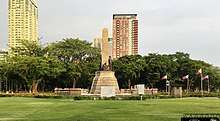
| N W 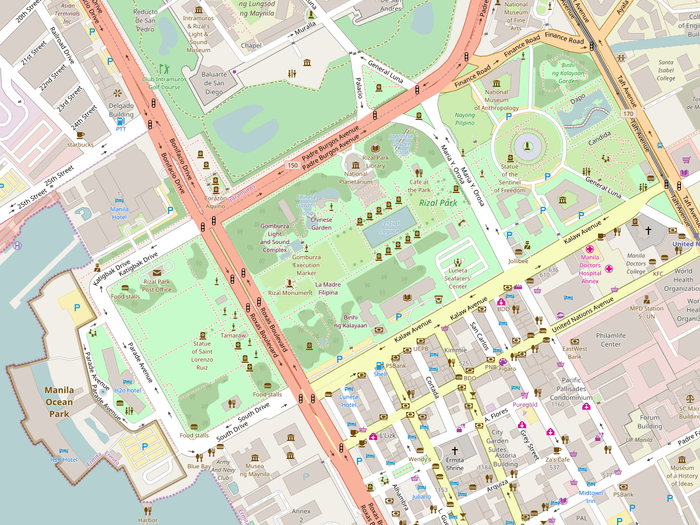 S | ||||
| Northeastern side | ||||
| Northwestern side | Southeastern side | |||
National Museum of Anthropology |
Agrifina Circle and the Sentinel of Freedom |
_Facade_-_Front_View.jpg) National Museum of Natural History | ||
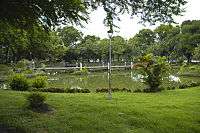 Japanese Garden |
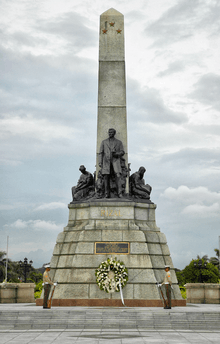 Rizal Monument |
National Library of the Philippines | ||
Intramuros |
National Historical Commission of the Philippines | |||
.jpg) Manila Hotel |
Quirino Grandstand |
Museo Pambata, formerly the Manila Elks Club | ||
| Southwestern side | ||||
Gardens
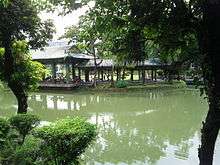
- Children's Playground, the section of the park built for kids, is located at the southeastern corner of the Rizal Park. The playground was also renovated in 2011.[21]
- Chinese Garden. An ornate Chinese-style gate, carved with swirling dragons, leads you into this whimsical garden which looks like it has been transported from old Peking. Along the lagoon constructed to simulate a small lake, are pagodas and gazebos that are set off by red pillars and green-tiled roofs and decorated with a profusion of mythical figures.
- Japanese Garden. The gardens were built to promote friendship between Japan and the Philippines. Inside is nice place for pleasant walks around the Japanese style gardens, lagoon and bridge.
- Noli me Tangere Garden, recently unveiled, It features the Heidelberg fountain where Rizal used to drink from when he was staying in Germany. It was donated as a symbol of Filipino-German friendship, The bust of Ferdinand Blumentritt can be found at the garden.
- Orchidarium and Butterfly Pavilion, established in 1994, was a former parking lot developed into a one-hectare rainforest-like park. The Orchidarium showcases Philippines' rich collection of orchid species and butterflies. The pavilion is also a favorite venue for weddings.
Event venues
- Open-air Auditorium, Designed by National artist for architecture, Leandro Locsin,It features performances provided for free to the general public by the National Parks Development Committee, Department of Tourism and the National Broadcasting Network. Free entertainment are also provided elsewhere in the park.[25] Featured shows are a mix of performances from dance, theatre, to musical performances by local and foreign artists. This is also the venue for the Cinema in the Open-Air, which provides free showing of critically acclaimed films.
- Quirino Grandstand, Originally called grand Independence Grandstand. It was designed by architect Juan M. Arellano, in preparation for the proclamation of Independence on July 4, 1946, and to avoid overcrowding in front of the Legislative Building during the inauguration of the Third Philippine Republic. It was designed in Neoclassical style. However, in 1949 Federico Illustre, chief architect at the Bureau of Public Works, modify the some designs of Arellano. It was completed on the reclaimed area along Manila Bay where President Elpidio Quirino was sworn in after winning the presidential election. Since then, newly elected Presidents of the Philippines traditionally take their oath of office and deliver their inaugural address to the nation in the grandstand, which was later renamed after President Quirino. Many important political, cultural and religious events in the post war era have been held here.
- Parade grounds and the Burnham Green, Parade grounds is a popular venue for fun run, races, motorcades and parades. The Burnham Green, named after American architect Daniel Burnham is a large open space in front of the Quirino grandstand, Designed to accommodate large crowd gatherings at the park, It also serves as picnic grounds and venue for different sports activities. The Narra tree planted by Pope Paul VI and the bronze statue of San Lorenzo Ruiz that was given by Pope John Paul II can be found in this area.
- Valor's Hall/Bulwagan ng Kagitingan, situated at the light and sound complex, Its artistic landscape and design made it one of the top-pick venues for event and cocktail receptions.
Educational establishments
- National Planetarium
- National Museum of Natural History
- National Museum of Anthropology, on the building north of Agrifina Circle, are the Anthropology and Archeology collections of the National Museum of the Philippines.
- National Library of the Philippines is the country's premier public library. The library has a history of its own and its rich Filipiniana collections are maintained by the librarians to preserve the institution as the nations fountain of local knowledge and source of information for thousands of students and everyday users in their research and studies.
- National Museum of Fine Arts, located on the northeastern tip of Rizal Park, is an art museum of the National Museum of the Philippines.
- Manila Ocean Park is an oceanarium located in the westernmost part of Luneta behind the Quirino Grandstand and along Manila Bay. The complex opened on March 1, 2008.
Artworks and monuments
- Artist's Haven/Kanlungan ng Sining, A site of artistic and natural artworks, It houses the gallery run by the Arts Association of the Philippines (AAP), in collaboration with the NDPC.
- Artworks in the Park, The Rizal park features different artworks of some renowned Filipino artists:
- Dancing Rings, A replica of Joe Datuin's Dancing Rings, The original sculpture is the Grand Prize winner of the 2008 International Olympic Committee Sports and Arts Contest in Lausanne, Switzerland.
- The New Filipino/Ang Bagong Pinoy, A sculpture by Joe Dautin, It features intertwined rings resemble a human figure that represents a new Filipino.
- Ang Pagbabago (The Change) Mosaic Murals, It represents the Filipino ideals of peace, love, unity and prosperity. It serves as a call to national renewal and change.
- Diorama of Rizal's Martyrdom. On an area north of Rizal monument stands a set of statues depicting Rizal's execution, situated on the spot where he was actually martyred, contrary to popular belief that the monument is the spot where he was executed. In the evenings, a Light & Sound presentation titled "The Martyrdom of Dr. Jose Rizal", features a multimedia dramatization of the last poignant minutes of the life of the Filipino patriot. Rizal's poem Mi Ultimo Adios engraved in a black granite, can also be found here.[26]
- Filipino-Korean Soldier Monument. This monument of two Filipino soldiers aiding a Korean soldier is dedicated to the Filipino combat soldiers who fought with the Korean troops during the Korean War.[27]
- Soul waves, It represents sea waves as a tribute to Filipino who died during the World War II, It is placed in the park by Korea, as a sign of mutual respect.
- The Flower Clock, features a clock on a flower bed. A feature of the park since the 1960s, it was restored in 2011. The clock's hand was sculpted by Filipino Artist, Jose Datuin.
- The Gallery of Heroes, is a row of bust sculpture monuments of historical Philippine Heroes. There are 2 rows on both sides of the Central Lagoon, one row on the North Promenade and another row on the South Promenade
- Relief map of the Philippines is a giant raised-relief map of the country, including the Scarborough Shoal, Kalayaan, and eastern part of Sabah, in the middle of a small man-made lake.
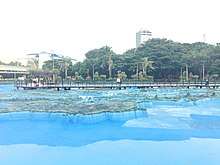 Relief map of the Philippines
Relief map of the Philippines - Statue of the Sentinel of Freedom (or the Lapu-Lapu Monument). The monument was a gift from the people of Korea as appreciation and to honor the memory of freedom-loving Filipinos who helped during the Korean War in the early 1950s (as inscribed in the plaque). Lapu-Lapu was a native Visayan chieftain in Mactan, Cebu and representative of the Sultan of Sulu, and is now known as the first native of the archipelago to resist Spanish colonization. He is retroactively regarded as the first hero of the Philippines. On the morning of April 27, 1521, Lapu-Lapu and the men of Mactan, armed with spears and kampilan, faced Spanish soldiers led by Portuguese captain Ferdinand Magellan in what would later be known as the Battle of Mactan. Magellan and several of his men were killed.
Other features
- Independence Flagpole, standing at 105 feet (32 m), is the highest flagpole in the Philippines. On this spot in front of Rizal Monument, at 9:15 am July 4, 1946, the full independence of the Republic of the Philippines was proclaimed as authorized by the United States President Harry S. Truman. As of August 2013, the flagpole was restored and increased its height to 150 feet (46 m). The government is expected to spend 7.8 million pesos, in preparation for the centennial of Rizal Monument[28]
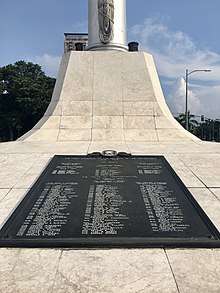 Independence Flagpole
Independence Flagpole - Kilometre Zero is located within the Park on Roxas Boulevard, in front of the Rizal Monument. It serves as the point from which all road distances from Manila are measured.[29]
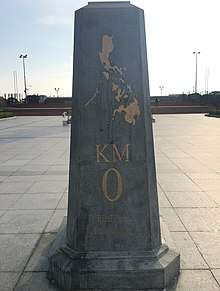
- Musical Dancing Fountain, Deemed as the biggest and most vibrant dancing fountain in the country, The central lagoon present a show with waters soaring up to 88 feet., fireballs, exploding water rockets and peacock spray water screen.
Flora
According to the inventory made by the National Parks Development Committee, there are 3,497 trees in Rizal Park belonging to 112 species as of 2015. 527 of the individual trees are Narra.[30]
Security
In 2012, 30 high-definition closed-circuit television (CCTV) cameras were installed to make the area safer for local and foreign tourists.[31] The National Parks Development Committee have stationed police and security officers in the key places in the park for added security.[21]
In popular culture
- The Amazing Race 5, the fifth installment of the American reality television show The Amazing Race, featured the Rizal Monument on Leg 12 as Route Marker.
- The Port Malaya patch in Ragnarok Online, a massively multiplayer online role-playing game (MMOPPG), features a replica of the Rizal Monument as one of the town's attractions.[32]
Gallery
 The park during the 119th Rizal Day commemoration
The park during the 119th Rizal Day commemoration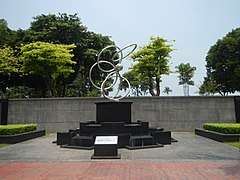 Dancing Rings sculpture
Dancing Rings sculpture- The entrance arch to the Chinese garden
- Gomburza execution site
.jpg) Carabao sculpture
Carabao sculpture- Kilometre Zero
 Kilometro Kupong ng Pilipinas (Philippine kilometre zero)
Kilometro Kupong ng Pilipinas (Philippine kilometre zero)
Rizal Parks elsewhere
Like Rizal Avenues, most Philippine towns and cities have a Rizal Park (or a Plaza Rizal), usually its central square. This is also where its Rizal monument is located. Seattle also has its own Rizal Park.
See also
- Jose Rizal
- Rizal Monument
- Paco Park
References
- Joaquin, Nick (1990). Manila My Manila. Manila: The City of Manila.
- "Trivia: 11 things you didn't know about the Black Nazarene". InterAksyon.com. Archived from the original on November 4, 2016. Retrieved November 3, 2016.
- (1911–12). "The Century Magazine", p.237-249. The Century Co., NY, 1912.
- "History – Spanish Period" Archived September 7, 2012, at the Wayback Machine. Rizal Park. Retrieved on October 7, 2011.
- "Manila and suburbs, 1898". University of Texas in Austin Library. Retrieved on October 7, 2011.
- Jernegan, Prescott Ford (1995). "A Short History of the Philippines", p.252. New York: D. Appleton and Company.
- Vicente, Rafael L. (2005). "The Promise of the Foreign Nationalism and the Technics of Translation in the Spanish Philippines", p. 36. Duke University Press.
- Division of Insular Affairs, War Department (1901). "Public Laws and Resolutions Passed by the United States Philippine Commission", p.689. Washington: Government Printing Office.
- (1905–06). "Proposed Monuments and Monuments News", p.40. Granite, Marble and Bronze Magazine Vol. 15.
- http://www.visitmyphilippines.com/index.php?title=CityofManila&func=all&pid=2557
- Torres, Cristina Evangelista (2014). "The Americanization of Manila, 1898 – 1921", p.169. Quezon City: University of the Philippines Press.
- "Executive Order No. 52, s. 1954". Official Gazette (Philippines). Retrieved February 15, 2017.
- "The Centenary of the Rizal Monument". Official Gazette (Philippines). Retrieved February 15, 2017.
- "Proclamation No. 234, s.1955". Official Gazette of the Republic of the Philippines. Retrieved July 10, 2014.
- "Proclamation No. 470, s. 1957". Official Gazette (Philippines). Retrieved February 15, 2017.
- "Executive Order No. 30, s. 1963". Official Gazette (Philippines). Retrieved February 15, 2017.
- "National Parks Development Committee". National Parks Development Committee. Archived from the original on July 14, 2014. Retrieved July 10, 2014.
- "Proclamation No. 299, s. 1967". Official Gazette (Philippines). Retrieved February 15, 2017.
- Alcazaren, Paolo (July 10, 2010). "Grandstands and great public places". Philstar. Retrieved on February 28, 2011.
- Mejia-Acosta, Iris (May 25, 2011). "Luneta Celebrates Rizal's 150th Birthday with a Fresh Look". Pinay Ads.
- "Rizal Park, Intramuros sites temporarily closed amid COVID-19 spread". Manila Bulletin. Retrieved March 16, 2020.
- "House Bill No. 2594" (PDF). Congress of the Philippines. July 24, 2019. Retrieved February 6, 2020.
- Hegina, Aries Joseph (January 18, 2015). "MMDA: 6M Filipinos attended Pope Francis' Luneta Mass, papal route". Philippine Daily Inquirer. Retrieved January 19, 2015.
- "Events" Archived November 1, 2012, at the Wayback Machine. Rizal Park – NPDC. Retrieved on March 21, 2013.
- "The Martyrdom of Dr. Jose Rizal" Archived November 30, 2011, at the Wayback Machine. Rizal Park – NPDC. Retrieved on October 8, 2011.
- The Rizal Park 2012 brochure. Department of Tourism.
- Maranga, Mark Anthony (2010). "Kilometer Zero: Distance Reference of Manila". Philippines Travel Guide. Retrieved on February 28, 2011.
- Teves, Catherine (August 16, 2019). "NPDC to revive Rizal Park with more indigenous trees". Philippine News Agency. Retrieved August 16, 2019.
- "CCTV cameras seen to make Manila's Luneta Park safer". Yahoo! Philippines. Retrieved February 24, 2013.
- Otakultura.com (2011). "Malaya Map Revealed!" Archived October 3, 2011, at the Wayback Machine. Retrieved on September 1, 2011.
